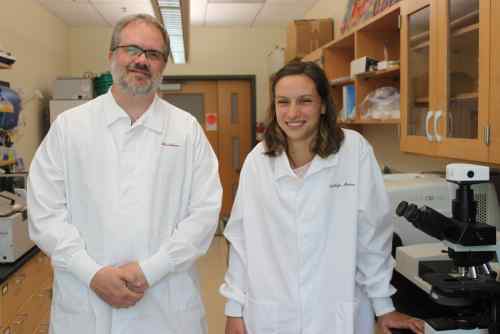Examining Cellular Pathways
A John Toll Fellow conducting neuroscientific research on campus this summer, Kaitlyn Marino ’19 is using a zebrafish model to test memory after stroke.

A zebrafish egg looks like nothing more than a tiny bubble of carbonated water, but this translucent organism contains a world of hope for the scientific research community investigating how to treat stroke in human patients.
Kaitlyn Marino ’19, a dual major in biology and psychology with a concentration in behavioral neuroscience, is part of that community. In the lab of her faculty adviser, Assistant Professor of Biology Jim Windelborn, she carefully collects fertilized eggs from the bottom of a narrow fish tank she and Windelborn built specifically for this summer research project meant to establish that, in fish, hypoxia affects memory. Working under a microscope and using a microinjector, Marino inserts a single strand of DNA into the embryo and returns the eggs to the tank, where they then grow into adult zebrafish whose cells have been genetically altered to express a specific protein.
As part of the experiment, she and Windelborn introduce their subjects to hypoxia—mimicking the oxygen deficiency that stroke victims experience when a blocked artery disrupts the flow of blood and oxygen to the brain. Then they run a series of behavioral assays to look at memory and how it is affected by ischemic stroke. Using a novel object recognition test, Marino introduces an object into the tank—in this case, toy Smurfs—right before the fish have hypoxia. A day later, in fully oxygenated water, the fish are introduced to that object again, along with a new object.
“The idea is, we’re seeing how much time they spend with the novel object versus what is considered a familiar object,” Marino explains. “We’re also looking at how brain tissue is affected 24 hours post-hypoxia.”
It’s part of a long-term project that can help identify different protein targets and drugs that can bind with those proteins, Windelborn says.
“We are generally bad at treating strokes. There isn’t a whole lot to do after the fact,” says Windelborn, who studied the cellular and molecular bases of neurological traumas and neurological diseases as a doctoral student at University of Wisconsin, Madison. “What’s important is to identify new targets. Right now, we’re pretty far away from the clinic, but we’re finding that zebrafish offer a good model for identifying possible therapeutic targets.”
For Marino, this is her second summer in the Windelborn lab working on a zebrafish model for ischemic stroke that will also form the basis of her senior capstone project.
Intent on earning a doctoral degree in neuroscience and a career as a research scientist, she is narrowing down her list of graduate school possibilities.
“I like the kind of research we’re doing now where you have a big thing you are looking at—in our case, behavior—and we’re really targeting something cellular, so that’s where my interest comes from,” says Marino. “You can see more of a cause and effect. I like cellular pathways—the idea of linking biology to behavior.”
Windelborn has no doubt she will get into the school of her choice.
“I can think of a couple of things that will help with her grad school applications,” Windelborn says. “Last fall we went to the international neuroscience meeting, the Society for Neuroscience, which held its annual meeting last year in Washington, D.C. Kaitlyn and a former student of mine, Emani Silva, and I went to the meeting where they each presented posters. That was the most excitement I had ever seen being generated around my work. At a meeting that typically draws 35,000 attendees, where it’s so easy to get lost, people were seeking us out. They were so excited about the model that we’re using. It was a lot of fun to see my students fielding questions from all types of people.”
During her symposium presentation, Marino was approached by faculty members from universities from all over the country.
“They were asking questions about the model we were using, the implications of it, and where we are going next. It was really interesting to see different perspectives on the research we’ve been working on,” Marino says.
She and Windelborn will attend the annual meeting again this fall—this one in San Diego. To support her travel expenses, she has applied for funding from the Cater Society of Junior Fellows and from the Faculty for Undergraduate Neuroscience organization.